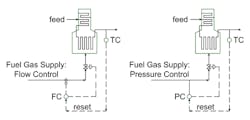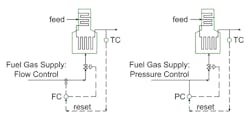Achieve Optimal Control of Fired Heaters
On occasion, ideas need to mature before you can come to a reasoned position on an approach to a problem. For myself, heater firing control is one of these areas. Figure 1 shows a simplified schematic of two methods of control. Both options adjust the fuel rate based on measurement of temperature, which is the most common parameter by far for monitoring the heater. On the left side of the figure, the temperature cascades and resets a flow controller. On the right side of the figure, the temperature cascades and resets a pressure controller. Both these systems are used widely but what circumstances favor one system over the other and why?
[pullquote]
Due to some work with clients, this question has been a concern of mine for the last three years. However, I’ve never come to what I consider a sound conclusion about which approach to use. Observation of industrial systems showed that performance differences between the two options seemed small. Nevertheless, on large heaters even small differences can save a lot of money over the years.
Proper evaluation of a control system requires understanding the types of disturbances the system might face. Let’s look at systems where the major disturbances are step changes in heat demand and alterations in fuel composition. Step changes in heat demand may force the plant to shut down or start up downstream burners. This alters the flow curve of the burner system. Here, the pressure drop for the fuel rate varies with no change in the process requirements. As fuel composition varies, so too does the heat value of the fuel. Different heating values mandate adjustment in fuel flow, even with no change in process duty.
Figure 1. The two common schemes use temperature to regulate either fuel flow or pressure.
Note: The pressure instrument should be downstream of the control valve, not upstream as shown on the drawing.
Burners take a high pressure drop. The burner itself acts as an orifice. Changing the number of burners alters the orifice area in the fuel flow system. Depending upon the control system, different responses can happen.
In flow control systems, adding a burner creates a dynamic drop in pressure downstream of the control valve. The sudden change in pressure may cause the burner management system (BMS) to trip the heater.
In pressure control systems, adding a burner creates a dynamic increase in fuel rate to the burners. The sudden change in fuel may cause the heater outlet temperature to go too high.
Basic principles suggest that flow control is superior. If fuel flow rate is kept constant, then heater outlet temperature should change little. The system moves the control valve to respond to fuel flow. The fuel flow is on the inside of the cascade. In contrast, a pressure control system responds quickly to maintain pressure — but at the constant pressure the fuel rate stays high. Eventually this shows up in high outlet temperature and corrects. However, the outlet temperature response is much slower. Added to this, the outlet temperature is on the outside of the cascade. Response to pressure control should be much slower.
[callToAction ]
However, based on observation of industrial units, control performance didn’t seem to vary much between the systems. Something else must be going on.
What about variations in fuel composition? Most flow systems measure volumetric flow rate, not mass rate. If your plant uses natural gas, this doesn’t make much difference. However, if your plant uses waste gases as fuel, compositions vary, altering the heating value of the fuel. Changes in heating value have to show up at the heater outlet before they can be corrected. Both the flow rate and the pressure control are equally slow.
Additionally, modern BMS controls often can cope very well with changes in the number of burners. Improved dynamic response with the volumetric flow controller frequently is small.
Recently, the American Petroleum Institute (API) has sponsored research on what type of system works better. Its conclusion, based on Monte Carlo analysis of multiple systems, is that a simple pressure control system performs slightly better than a volumetric flow control system for handling fuel composition changes. The benefit is small but definitely exists. The evaluation also included a number of attempts to adjust both the flow control and the pressure control systems with temperature, molecular weight and other corrections. None of these improved the fuel control.
The API did find one method that worked much better. This was mass flow control on the fuel. Industry experience using carefully calibrated instrumentation on large industrial heaters has confirmed, so far, the API’s conclusions. The full report should come out soon and will be well worth reviewing. So, watch for its release.
Fundamental analysis can reveal potential benefits for changes in industrial units. However, for an analysis to be credible, it also should explain existing observations. At the moment, some type of pressure control looks like a better choice for fuel volume control in industrial fired heaters that must cope with fuel composition changes. Specific control systems also must deal with startup, low-firing conditions, and other abnormal operations. This could change conclusions for a specific heater.


